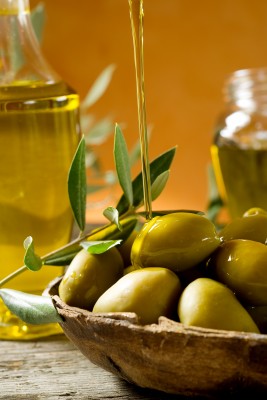If you are looking for the best extra virgin olive oil, at the best price, Costco’s Kirkland Signature brand is for you. Because most of us use so much oil in our gluten free baking, it is important to obtain the healthiest oil for you, yet at a reasonable price. Years ago I read that cold pressed olive oil is the healthies, but I just didn’t have enough information. Below is the result of my research. I hope you benefit from it.
Ad
[showmyads]
In 2010 UC Davis performed a study on olive oil and found that most imported “extra virgin” olive oil often fails the international and USDA. standards for Kirkland’s “organic” extra virgin olive oil to contain far less polyphenols (mainly natural, as well as synthetic or semisynthetic, organic chemicals). You surely can purchase a similar quality extra virgin olive oil, but it will cost you nearly double the price.
The UC Davis study on olive oil showed that the International Olive Council(IOC) and the United States Department of Agriculture (USDA) testing often fails to detect defective olive oil. Their results indicated that the samples of imported extra virgin olive oil sold in California stores included flavors of rancidity and mustiness. IOC and USDA testing methods were questioned, as 31% of the oils they tested using this method failed. However, using the Australian and German testing methods (DAGs and PPP) 86% of oils failed. See link above to view the chart results in their study.
CBS News reported in their 5 Things You Should Buy at Costco article that Kirkland’s Organic Extra Virgin Olive Oil is not only half the price of well known brands such as Bertolli brand, but much better. They base this fact on the UC Davis study.
The California Olive Oil Council has the only North American certification program for extra virgin olive oil, (COCC). They state that they offer a seal-certification which provides the highest standard of quality to American consumers. They list about 60 certified extra virgin olive oils. The oils listed there have met all requirements:
- Olives mechancially extracted without chemicals or excessive heat
- Less than .5% free oleic acid
- Positive taste elements and no taste defects, as determined during a blind tasting
However, they use the standards from the IOC/USDA versus actual lab analysis.
In October of 2010 the USDA implemented new standards for olive oil and olive-pomace oil. Their testing now includes: absorbency under ultraviolet light, color; the origin and purity of the oil; lab testing to determine whether the oil contains any seed oils and verifies the authenticity and origin of oils; testing for any other oils produced by solvent extraction; flavor and odor; free fatty acid content; the molecular structure of the fats and oils to determine whether they are mono-, di-, or triglycerides; level of linolenic acids which determines the purity of the oil; tasting by a panel which results in the following: fusty (due to poor storage), muddy-sentiment, musty, rancid, winey-vinegary; as well as tasting virgin olive oil for a fruity, nutty, etc. flavor; odor; level of active oxygen; level of steroid hydrocarbon which determines if the oil is refined; a sterol analysis, again searching for seed oil or impurities; any trans fatty acids which is an indication of refinement; triglyceride level; and wax content, an indication of seed oil or pomace oil.
This year the USDA included olive oil in their Quality Monitoring Program, as stated on their blog about Quality Monitoring Expands to Olive Oil.
Australia recently increased their standards for olive oil. I found several sources online that stated the Australian Olive Oil Association found that most of the oils sold in Australian and the US were a dumping ground for poor quality olive oil, similar to “lamp oil grade”. I went to the website and found a letter they wrote to a government representative which included the following statement:
A complete supermarket survey funded by Rural Industries Research and Development Corporation (RIRDC) over a three year period (2009/10/11) showed that 18% of the 265 Extra Virgin Olive Oils (EVOO) tested were not only outside the Extra Virgin grade but they were chemically classified as lampante while other 25% of the samples was outside the Extra Virgin grade and only a few weeks away from falling into the lampante grade as well. According to AS 5264-2011 and all other internationally recognised olive oil standards, lampante oils are NOT SUITABLE FOR HUMAN CONSUMPTION.”
The USDA has something similar. It lists different types of olive oils, and one is “U.S. Virgin Olive Oil Not Fit For Human Consumption Without Further Processing” sometimes designated as “U.S. Lampante Virgin Olive Oil”.
(a) Organoleptic Characteristics
- Odor And Flavor
- Odor And Flavor (On A Continuous Scale):
- Median Of Defect (Md)
- Median Of The Fruity (Mf)
- Color
(b) Free Fatty Acid Content, % m/m Expressed As Oleic Acid
(c) Peroxide Value, In Milleq. Peroxide Oxygen Per kg/oil
Any oil receiving a negative grade in a, b, or c above is determined to meet the requirements of lampante oil (not consumable for human consumption).
Which oil do you use and why?
As a side note, too bad we couldn’t get the USDA to mandate gluten-free labeling instead of the FDA, however, the USDA is too busy protecting the farmers. This is why tobacco will never be band.
Stay tuned in for tomorrow’s latest gluten free recipe, Gluten Free Corn Dogs!
Ad
[showmyads]



